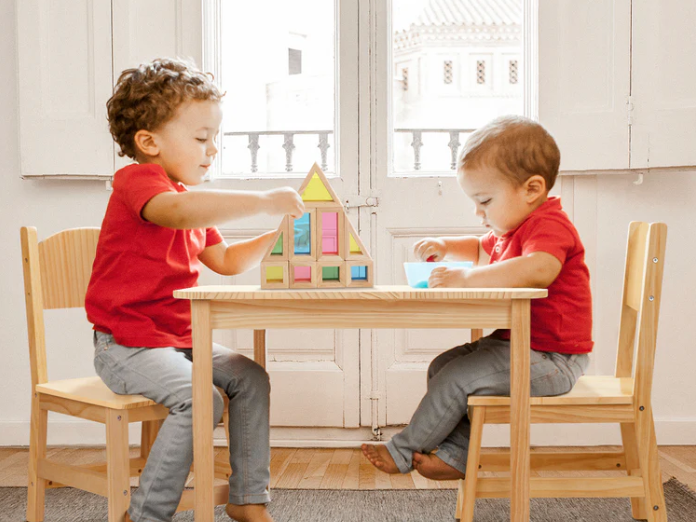Investment Pieces: Furniture That Pays for Itself Over Time
There's a moment that happens in almost every parent's life—you're standing in a big-box store staring at a children's table that costs $49.99, and you're doing mental math. It'll probably last a year, maybe two if you're lucky. Then you'll be back here again, wallet in hand, replacing the wobbly legs or the chipped surface that's started peeling.
Meanwhile, that solid wood table you saw online costs five times as much, and your brain is screaming that it's ridiculous to spend that kind of money on furniture for a three-year-old who's probably going to spill juice on it tomorrow.
We get it. The sticker shock is real, and in a world of car payments, grocery bills, and endless expenses that come with raising children, it's hard to justify spending more upfront. But here's what we've learned from families who've made the switch from disposable furniture to investment pieces: quality furniture doesn't just last longer—it actually saves you money, stress, and countless trips to furniture stores over the years.
The Real Math Behind Furniture Investment
Let's talk numbers, because this isn't just about feeling good—it's about making smart financial decisions for your family. That $50 table might seem like a bargain, but if you replace it every 18 months for a decade, you've actually spent $400 on something that ends up in a landfill multiple times. The $250 solid wood table that lasts 15 years? You've spent less than $17 per year of use.
But the calculation goes deeper than simple division. Quality furniture maintains its value in ways that disposable furniture never can. Solid wood pieces can be refinished, repaired, and refreshed. That scratch from learning to use scissors? It adds character rather than requiring replacement. The water ring from a forgotten cup? It can often be removed or incorporated into the piece's story.
Perhaps most significantly, investment furniture holds resale value. When your children outgrow their solid wood table and chairs, you can sell them for a meaningful portion of what you paid—sometimes even more if they've been well-maintained. Try selling used particle board furniture and you'll quickly discover it has essentially zero secondhand value.
What Makes Furniture Worth the Investment
Not all expensive furniture is worth the investment, and not all investment-worthy furniture is expensive. The key is understanding what separates pieces that will serve your family for decades from those that are simply overpriced.
Solid wood construction forms the foundation of any true investment piece. Real wood—whether it's oak, maple, alder, or walnut—has inherent structural integrity that engineered materials simply cannot match. Particle board and plywood might look fine on day one, but they deteriorate with normal use. Solid wood, on the other hand, becomes more beautiful with age, developing a patina that tells the story of your family's life.
The difference becomes especially apparent when furniture gets wet, which is basically guaranteed with children. Solid wood can dry out and be restored. Particle board swells, weakens, and crumbles. That's not a flaw you can repair—it's the end of the furniture's useful life.
Construction quality matters just as much as materials. Look for joints that are actually joined—dovetails, mortise and tenon, dowels—rather than simply glued or stapled together. Quality hardware that can be tightened over time rather than plastic components that crack and break. These details might not be visible in product photos, but they determine whether furniture lasts two years or twenty.
The finish on your furniture deserves serious consideration, especially for children's pieces. Many parents don't realize that conventional furniture finishes contain volatile organic compounds that off-gas into your home's air for months or even years. Beyond the health implications, these finishes often chip, peel, and show wear quickly. Zero-VOC finishes like those used on AlderBourn furniture not only protect your family's health but actually provide superior durability. When the finish is molecularly bonded to the wood rather than sitting on top as a coating, it withstands the daily abuse that children's furniture endures while remaining safe enough that you never worry about what your child is exposed to.
The Hidden Costs of Cheap Furniture
The price tag is only the beginning of what cheap furniture actually costs your family. There's the time spent shopping for replacements every year or two—time that could be spent with your children rather than wandering furniture stores. There's the frustration of assembly and disassembly, of hauling items in and out of your home, of dealing with wobbly legs and drawers that never quite close right.
Consider the environmental cost too. Furniture that's designed to be replaced frequently creates an enormous waste stream. The average American throws away nearly 10 million tons of furniture annually, much of it ending up in landfills where particle board and chemical finishes leach into soil and groundwater. When you choose furniture built to last, you're not just making a financial decision—you're making an environmental one.
There's also an emotional cost to disposable furniture that's harder to quantify but deeply felt. Children notice when their furniture is flimsy, when chairs wobble, when surfaces peel and chip. Quality furniture communicates something important: that they're worth investing in, that their spaces matter, that the things made for them are built with care and intention.
Furniture That Grows With Your Child
The most valuable investment pieces are those that adapt to your child's changing needs. A well-designed table at toddler height today can become a craft station for a school-aged child, a homework desk for a middle schooler, and eventually move to a teenager's room as a side table or display surface. This adaptability is only possible with furniture that's built to endure and maintain its relevance.
Solid wood's natural beauty means it fits seamlessly into different design schemes as your child's tastes evolve. The colorful plastic furniture that delights a three-year-old often embarrasses a ten-year-old, but classic wood pieces transcend age-specific trends. They're sophisticated enough for teenagers while remaining approachable for toddlers.
This longevity means you're not just investing in furniture—you're investing in pieces that can become part of your family's story. That table where your daughter learned to draw, where your son built his first LEGO creation, where both children eventually did homework together—it's not just furniture at that point. It's a repository of memories, and its continued presence provides tangible connection to those earlier years.
Beyond Your Own Children
Here's something that doesn't get talked about enough in furniture discussions: investment pieces don't have to stop serving your family when your children outgrow them. Quality children's furniture seamlessly transitions to guest rooms, home offices, or craft spaces. That small table becomes the perfect plant stand or entryway accent. Those sturdy chairs find new life around a game table or reading nook.
Many families also discover that investment furniture becomes something they're proud to pass down. Grandchildren inherit pieces that their parents used, creating a tangible connection across generations. This heirloom potential simply doesn't exist with disposable furniture—not because cheap furniture isn't sentimental, but because it physically cannot survive long enough to become an heirloom.
There's also a robust secondhand market for quality children's furniture. Parents are actively seeking solid wood pieces that will last, and they're willing to pay fair prices for gently used items. This means when you're truly done with a piece, you can recoup a significant portion of your investment rather than having to pay to haul worthless furniture to the dump.
Making the Investment Work for Your Budget
The idea of investing in quality furniture can feel overwhelming when you're furnishing an entire children's room or play space. The good news is that you don't have to do it all at once, and strategic choices can maximize your investment.
Start with pieces that get the most use and abuse—typically tables and seating. These are the items where quality construction makes the biggest difference in longevity. A solid wood table and chairs set will outlast multiple toy storage solutions, so it makes sense to prioritize it.
Consider buying pieces as gifts for major occasions. Many grandparents, aunts, and uncles appreciate the opportunity to give meaningful gifts that will last, and quality furniture fits that desire perfectly. A beautiful wooden bookshelf or table set becomes both a practical necessity and a lasting reminder of their love and support.
Watch for seasonal sales or direct-from-maker options that eliminate retail markup. Some of the best values in investment furniture come from companies that sell directly to consumers, allowing them to offer higher quality at more accessible prices than traditional retail markup would allow.
The Satisfaction of Choosing Quality
Beyond the financial and practical benefits, there's something deeply satisfying about bringing quality furniture into your home. It changes the energy of a space immediately—things feel more intentional, more permanent, more valued. Children pick up on this without anyone saying a word.
Parents consistently report that quality furniture actually makes their homes more enjoyable to live in. There's no nagging worry about whether the chair will collapse, no constant reminders to "be careful" because everything is so fragile. Instead, furniture becomes the reliable foundation that supports family life rather than something that requires constant management and concern.
There's also pride in making choices that align with your values. When you choose solid wood over particle board, zero-VOC finishes over chemical coatings, and durability over disposability, you're voting with your dollars for the kind of manufacturing and consumption you want to support.
The truth about investment furniture is that it's not really about the furniture at all. It's about creating spaces where your family can thrive without worry, about making choices that reflect your values, and about having one less thing in your life that needs constant replacement and management. In a world of planned obsolescence and disposable everything, choosing pieces built to last is quietly radical—and deeply satisfying.
What investment furniture pieces have served your family best over the years? We'd love to hear about the items that have earned their keep in your home!
Ready to invest in furniture that will grow with your family? Explore our collection of solid wood children's furniture with zero-VOC finishes, designed to last for generations at www.alderbourn.com.

